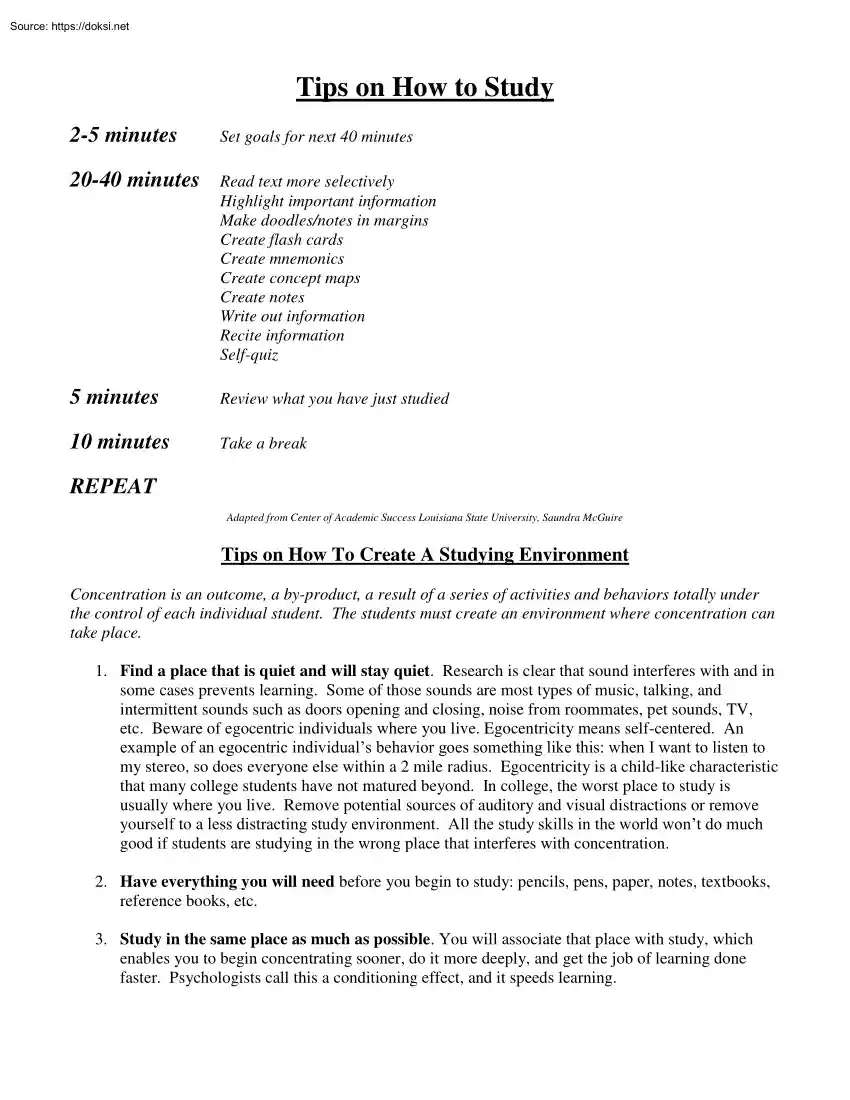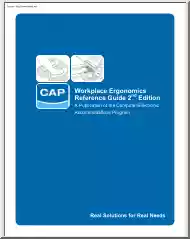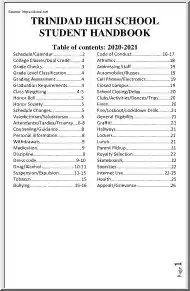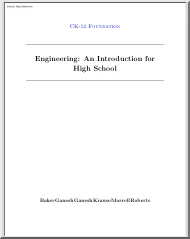A doksi online olvasásához kérlek jelentkezz be!

A doksi online olvasásához kérlek jelentkezz be!
Nincs még értékelés. Legyél Te az első!
Mit olvastak a többiek, ha ezzel végeztek?
Tartalmi kivonat
Tips on How to Study 2-5 minutes Set goals for next 40 minutes 20-40 minutes Read text more selectively Highlight important information Make doodles/notes in margins Create flash cards Create mnemonics Create concept maps Create notes Write out information Recite information Self-quiz 5 minutes Review what you have just studied 10 minutes Take a break REPEAT Adapted from Center of Academic Success Louisiana State University, Saundra McGuire Tips on How To Create A Studying Environment Concentration is an outcome, a by-product, a result of a series of activities and behaviors totally under the control of each individual student. The students must create an environment where concentration can take place. 1. Find a place that is quiet and will stay quiet Research is clear that sound interferes with and in some cases prevents learning. Some of those sounds are most types of music, talking, and intermittent sounds such as doors opening and closing, noise from roommates, pet sounds,
TV, etc. Beware of egocentric individuals where you live Egocentricity means self-centered An example of an egocentric individual’s behavior goes something like this: when I want to listen to my stereo, so does everyone else within a 2 mile radius. Egocentricity is a child-like characteristic that many college students have not matured beyond. In college, the worst place to study is usually where you live. Remove potential sources of auditory and visual distractions or remove yourself to a less distracting study environment. All the study skills in the world won’t do much good if students are studying in the wrong place that interferes with concentration. 2. Have everything you will need before you begin to study: pencils, pens, paper, notes, textbooks, reference books, etc. 3. Study in the same place as much as possible You will associate that place with study, which enables you to begin concentrating sooner, do it more deeply, and get the job of learning done faster.
Psychologists call this a conditioning effect, and it speeds learning 4. Study with a pen or pencil in hand According to an expert in concentration, Dr Pauk, you should study with a pen or pencil in hand and use it to take notes. The activity of taking notes increases concentration. Use the Cornell System for lecture notes or the Notecard System for textbook notes. 5. Vary your study activities If you study style is not to focus on one subject for a long period, then vary what you do. Read and take notes for a while, formulate answers and questions for a time, then recite and review your Q and A’s to break the monotony. An example is to do math problems, then take notes from your psychology text, quiz yourself on the psychology notes, and then go back to math. 6. Eat well balanced, regular meals Research indicates that those with healthier diets earn higher grades. Avoid quick “uppers” such as sugary snacks because quickly rising and falling blood sugar levels negatively
affect concentration. High fat foods cause sluggishness and drowsiness Choose to snack on fresh fruits and vegetables instead. 7. Get Plenty of Nighttime Sleep Fighting sleepiness lowers concentration If your living environment prevents sufficient nighttime sleep, change it. It is your future at stake College students need between 7 and 9 hours of nighttime sleep to not hinder learning ability. 8. Use a worry sheet Each time you catch yourself worrying about something, jot it down on a piece of paper. Then do something about each item as soon as you can If worrying prevents you from concentrating, use the expertise of the campus counseling center staff. They help students with personal concerns every day and may just have the information and assistance that you need. 9. Intend to Concentrate Sounds simple Humans tend to do what they tell themselves to do Therefore, it’s easier to concentrate if you set a specific length of time to study and consciously tell yourself that “I will
concentrate” for that length of time. It is easier to concentrate when there is a starting and ending time. 10. Adopt a proven system for studying and learning An effective step-by-step plan for studying and learning makes concentration easier. For example, take main ideas, turn them into questions, and place them on one side of a notecard. On the other side, use the details that clarify and explain each main idea as answers to your questions. Frequently and regularly, look at the note cards and practice reciting the answer aloud from memory. Then turn the notecard over to check your answer. If right, move on to the next notecard If wrong, do not move on until you read the answer aloud and re-quiz yourself until you get it right. This activity promotes concentration Reading, and rereading, and rereading, and rereading does not. If you study by rereading and suffer from poor concentration and recall, you are normal. 11. Take regular study breaks It is normal for concentration time to
vary individually from 5 minutes, to 20 minutes, to an hour and on up. Take short 5 minute breaks when concentration wanders. Use the restroom, get a drink of water, or look out the window There is a danger in starting conversations with others during breaks. Many conversations turn out to be more interesting than the studying at hand. 12. Study away from the temptations of your computer such as email, games, and exploring the internet. Turn off cell phones when trying to concentrate Dennis Congos, University of Central Florida Tips on How to Read and Find The Important Facts Here’s a formula for finding the important facts in a chapter. 1. GET THE BIG PICTURE FIRST Quickly skim: The chapter title (and think about the topic) The introduction (for an overview) The major headings (quick idea of key concepts) The chapter summary (for a condensed version) 2. READ EACH SECTION WITH A QUESTION IN MIND Why? (It’s easier to find an answer if you know the question)
How? (Use the heading/subheading that begins each new section) What kinds of questions work? (Open-ended questions work best- What? Why? How?) 3. MARK INFORMATION THAT ANSWERS YOUR QUESTION Read actively. Search for the answer to your question Try not to get bogged down in every detail. Look for: main ideas (try first/last sentences of paragraphs and the section) bold faced terms (and the details that explain them) examples (that make abstract ideas understandable Mark these points sparingly (underline, star, circle, etc.) 4. CONFIRM YOUR ANSWER Does the information you marked answer the question you made? Find out before reading the next section. Use your own words Say the answer out loud or write a brief summary note in the margin of the text. Ohio University
TV, etc. Beware of egocentric individuals where you live Egocentricity means self-centered An example of an egocentric individual’s behavior goes something like this: when I want to listen to my stereo, so does everyone else within a 2 mile radius. Egocentricity is a child-like characteristic that many college students have not matured beyond. In college, the worst place to study is usually where you live. Remove potential sources of auditory and visual distractions or remove yourself to a less distracting study environment. All the study skills in the world won’t do much good if students are studying in the wrong place that interferes with concentration. 2. Have everything you will need before you begin to study: pencils, pens, paper, notes, textbooks, reference books, etc. 3. Study in the same place as much as possible You will associate that place with study, which enables you to begin concentrating sooner, do it more deeply, and get the job of learning done faster.
Psychologists call this a conditioning effect, and it speeds learning 4. Study with a pen or pencil in hand According to an expert in concentration, Dr Pauk, you should study with a pen or pencil in hand and use it to take notes. The activity of taking notes increases concentration. Use the Cornell System for lecture notes or the Notecard System for textbook notes. 5. Vary your study activities If you study style is not to focus on one subject for a long period, then vary what you do. Read and take notes for a while, formulate answers and questions for a time, then recite and review your Q and A’s to break the monotony. An example is to do math problems, then take notes from your psychology text, quiz yourself on the psychology notes, and then go back to math. 6. Eat well balanced, regular meals Research indicates that those with healthier diets earn higher grades. Avoid quick “uppers” such as sugary snacks because quickly rising and falling blood sugar levels negatively
affect concentration. High fat foods cause sluggishness and drowsiness Choose to snack on fresh fruits and vegetables instead. 7. Get Plenty of Nighttime Sleep Fighting sleepiness lowers concentration If your living environment prevents sufficient nighttime sleep, change it. It is your future at stake College students need between 7 and 9 hours of nighttime sleep to not hinder learning ability. 8. Use a worry sheet Each time you catch yourself worrying about something, jot it down on a piece of paper. Then do something about each item as soon as you can If worrying prevents you from concentrating, use the expertise of the campus counseling center staff. They help students with personal concerns every day and may just have the information and assistance that you need. 9. Intend to Concentrate Sounds simple Humans tend to do what they tell themselves to do Therefore, it’s easier to concentrate if you set a specific length of time to study and consciously tell yourself that “I will
concentrate” for that length of time. It is easier to concentrate when there is a starting and ending time. 10. Adopt a proven system for studying and learning An effective step-by-step plan for studying and learning makes concentration easier. For example, take main ideas, turn them into questions, and place them on one side of a notecard. On the other side, use the details that clarify and explain each main idea as answers to your questions. Frequently and regularly, look at the note cards and practice reciting the answer aloud from memory. Then turn the notecard over to check your answer. If right, move on to the next notecard If wrong, do not move on until you read the answer aloud and re-quiz yourself until you get it right. This activity promotes concentration Reading, and rereading, and rereading, and rereading does not. If you study by rereading and suffer from poor concentration and recall, you are normal. 11. Take regular study breaks It is normal for concentration time to
vary individually from 5 minutes, to 20 minutes, to an hour and on up. Take short 5 minute breaks when concentration wanders. Use the restroom, get a drink of water, or look out the window There is a danger in starting conversations with others during breaks. Many conversations turn out to be more interesting than the studying at hand. 12. Study away from the temptations of your computer such as email, games, and exploring the internet. Turn off cell phones when trying to concentrate Dennis Congos, University of Central Florida Tips on How to Read and Find The Important Facts Here’s a formula for finding the important facts in a chapter. 1. GET THE BIG PICTURE FIRST Quickly skim: The chapter title (and think about the topic) The introduction (for an overview) The major headings (quick idea of key concepts) The chapter summary (for a condensed version) 2. READ EACH SECTION WITH A QUESTION IN MIND Why? (It’s easier to find an answer if you know the question)
How? (Use the heading/subheading that begins each new section) What kinds of questions work? (Open-ended questions work best- What? Why? How?) 3. MARK INFORMATION THAT ANSWERS YOUR QUESTION Read actively. Search for the answer to your question Try not to get bogged down in every detail. Look for: main ideas (try first/last sentences of paragraphs and the section) bold faced terms (and the details that explain them) examples (that make abstract ideas understandable Mark these points sparingly (underline, star, circle, etc.) 4. CONFIRM YOUR ANSWER Does the information you marked answer the question you made? Find out before reading the next section. Use your own words Say the answer out loud or write a brief summary note in the margin of the text. Ohio University




